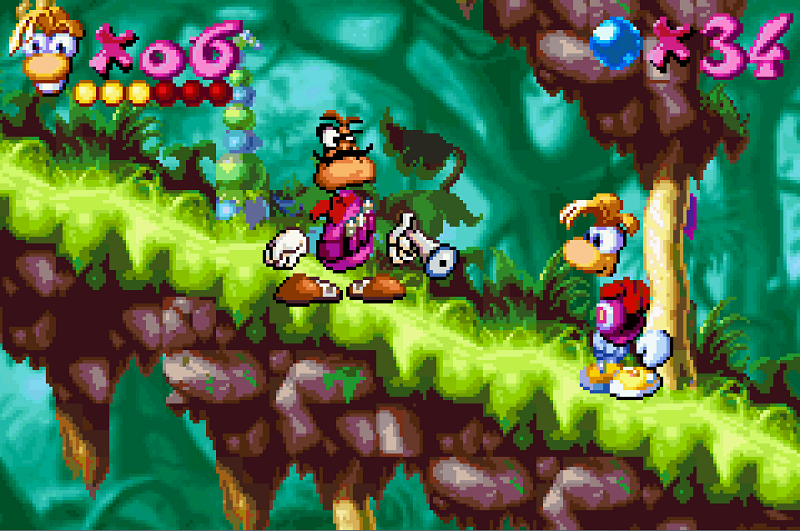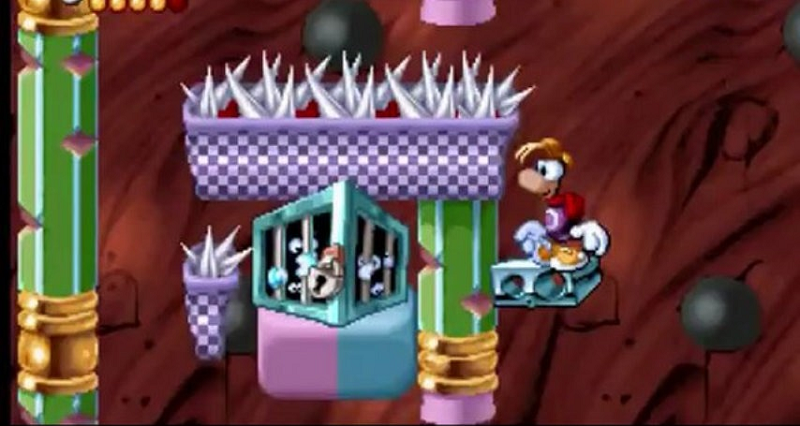Originally intended to be a co-op platformer for the SNES, Rayman found instead its way onto the Atari Jaguar in 1995, before arriving on the PlayStation around the same time. After its success, it again was ported to MS-DOS and Sega Saturn in 1996, before it was ported AGAIN to Game boy Advance, DS-i ware, PSN and more PC versions (especially in Europe). Thinking of how many platformers there where in the 90s, why did this one get so many ports and become so highly recognized?
“RAYMAN TO THE RESCUE”
As told by the Magician: The evil Mr. Dark has stolen The Great Protoon, which is the one who maintains peace and balance in Rayman’s world. After defeating Betilla the fairy, who tried to defend The Great Protoon, Mr. Dark’s forces also captured the Electoons, small, adorable creatures which now need a hero to save them. Rayman is that hero.

The story is nothing special, but it never overstays its welcome. The plot is shown in the opening and they even poke fun at it with whimsical dialog. The characters, while they don’t have much screen-time, are likeable and serve their purpose when they are around. All in all: the story is clearly not a focus, but it has personality and characters that are likeable. You are simply the hero and that’s all you need to know.
Story score: 7/10
Giving our limbless-hero his powers
Rayman starts of with only the ability to walk, jump, duck, crouch and make funny faces to scare certain enemies. You start of bare-bones, but eventually, as you progress, Betilla the fairy will grant you upgrades such as the ability to throw your fist as an attack, hang from ledges, swing on certain objects, helicopter-jump and running. Discovering your moves like this, might seem like an odd choice, but the levels are built around this concept, so you are never ill-equipped to deal with the challenges approaching.
The attack you will eventually get turns your fist into a projectile that can either be quickly thrown for short distances, or charged to punch harder and at long range. This attack will also return, like a boomerang, giving you the ability to attack enemies from behind. You are also able to get two power-ups for it that will disappear if you lose a life: one that will make it go faster and one that will deal twice the damage. It is simple, but effective and fun.

All the other abilities are more in aid of the platforming. Having the ability to grab ledges and instantly jump from it is a godsent and makes platforming fast-paced and a bit less nerve-wrecking. The same can be said for the helicopter-jump, that will make you float a short distance after a jump. The running ability will not just make you run faster, but also help you jump further, to reach distances that seemed unreachable. The only one that might be a bit more situational, is the “grab-fist” that makes you swing. It can only be used on certain objects, but it is quite useful and can make you go places you wouldn’t think of before.
The levels are chosen from an overworld map, each containing multiple stages with a clear objective to go from point A to B, unless there is a boss-fight. The stages are platforming-heavy, come with their own charm and make good use of Rayman’s abilities; from the slippery stages and dangerous notes of Bandland, to the melon-riding trips down the rivers in Dream Forest. Each stage varies in length and size, and can be explored for extra goodies or secrets. Besides powerups for your fists there are also small blue bubbles called “things” that can be collected to get an extra life, health-boosts, health regenerating items and Electoons that can be freed from their cages with a good punch. Freeing electoons is how you will progress to the next stages, kinda like how N64-platformers like Banjo-Kazooie and Mario 64 had you collect puzzle pieces and stars to unlock the next world. Each stage contains 6 Electoons and they can be well hidden, but you should always be able to find some, at least with a little exploration. Exploration in a 2D-platformer may sound like a reason to drag out the game, but the stages are often short enough and the hidden areas are never too obscure, so it adds to the enjoyment instead.

The boss-fights are quite fun and demand you to be at your A-game. One particular boss did drag on and is one of the weakest parts of the game, but it is all in all a fun and incredibly well done challenge. In fact: the whole game itself is tough, with hard stages, varied and deadly enemies and obstacles, and limited lives and continues. You can luckily save the game and there are even bonus-stages hidden in the levels that can grant you more lives, but seeing the continue-screen at least once, isn’t surprising. The game is never too hard, nothing is unfair, cheap or makes you feel ill-equipped. It is just quite the challenge.
Having so much variation, exploration and upgrades, yet still keep it simple and entertaining is an impressive feat. It always keeps me coming back with the “just one more stage” mentality until I am at the end-game.
Gameplay Score: 9/10
So bizarre and imaginative
Rayman’s visuals are stunning, both technically and artistically. It boasts a colorful and diverse world with anything from “band-land”, a music-themed land where you skate on notes, to paint-land, where pencils are sharp and deadly. Complimenting this bizarre universe are the inhabitants, odd creatures and enemies, from our limbless hero himself to drums with scuba-mask. The animations for them as well are really well done, especially on Rayman himself.

The soundtrack is quite the varied selection, from the peaceful tunes in the earlier stages to the more darker and grim areas in the later ones. It’s not just varied, but also memorable and beautiful, with tunes such as “high-notes” and “Betilla the Fairy” adding a wondrous and joyful atmosphere. With plenty of instruments adding to the soundtracks you get quite the performance and it is not hard to see why Remi Gazel (the main-composer for this game) is still performing his masterpieces to this day.
Presentation score: 10/10
So… where is the last stage?
After you have taken on one of the later stages, you might find yourself not progressing much further. That is because in order to unlock the last stage, you actually have to complete the game, meaning finding all 102 Electoons. This is certainly a challenge and one that can be hard due to the later stages being really difficult. This would have been almost to the point of padding, but by this point you will have the ability to run, so stages can be beaten much quicker and the other platforming-abilities will also make the search easier. Depending on how well you searched each area, this will add about twice or a third of the amount of time it took to get to the next-to last stage. All in all, it should take about 10-12 hours to complete the game, depending on both your skills in platforming and exploration.
Extras score: 8/10
Verdict
Rayman is still a phenomenal platformer that is imaginative and fun to play. While it might not be the most revolutionary game there is, it does everything so well and unique that it easily stands tall on its own. If I may recommend: the PlayStation has all the music, sound-effects, better draw-distance and might be the most visual pleasing, but Rayman Forever has 24 harder levels by the developers, a level editor and 100 levels made by the fans. Regardless however: there are plenty of versions of Rayman, so go with the platform that you are most comfortable with and play it there.

Wow, it’s like 15 years I don’t play Rayman. On my PC was almost impossible to run it. Too much memory needed and too expensive graphics. Good old times……
LikeLike
Those where the days^^
And I still struggle at times XD
LikeLiked by 1 person
Me too!
LikeLike